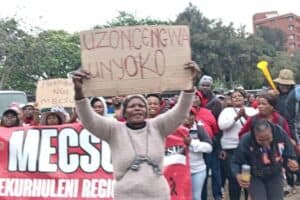SA’s public order units are understaffed and often have failing equipment.

Damned if we do, damned if we don’t that’s how we in the police sometimes feel when it comes to maintaining public order during violent demonstrations … and especially where we are forced to use rubber bullets.
There are plenty of articles and experts criticising the use of rubber rounds, but you’ll struggle to find one where the police side is understood.
Let’s start with the basics. Section 17 of our glorious constitution states: “Everyone has the right, peacefully and unarmed, to assemble, to demonstrate, to picket and to present petitions.”
At the same time, the Regulation of Gatherings Act 205 of 1993 defines “riot damage” as: “… any loss suffered as a result of any injury to or the death of any person, or any damage to or destruction of any property, caused directly or indirectly by, and immediately before, during or after, the holding of a gathering.”
Standing on our side of the line, we police officers often wonder why people taking part in gatherings and or demonstrations fail to grasp the concept of “peacefully and unarmed”.
And we wonder why there is no concerted effort to inform participants of their rights and obligations?
In other words, you have the right to protest, but you must do so peacefully and you must not have any weapons.
We are also mindful of our duties as members of the SA Police Service (Saps) to:
- Prevent, combat and investigate crime
- Maintain public order
- Protect and secure the inhabitants of the Republic and their property and
- Uphold and enforce the law.
SA is a violent country and in a violent country, it should not surprise anyone when “peaceful” protests turn violent.
According to ISSAfrica.org protest and violence map, SA experienced 7 056 incidents of protests from 2013 to 2021.
This, of course, does not include the recent unrest and looting across KwaZulu-Natal and Gauteng.
Against that, we, in the police, are under a constant barrage of criticism when we use crowd control tools such as rubber rounds.
Many critics have said this ammunition should be withdrawn completely because it has no place in modern protest
policing. Such critics often cite the tragic case of Andries Tatane, who was shot during a service delivery protest in the Free State in 2013.
Since Mr Tatane, the only other names mentioned in the press of deaths related to rubber bullets are Letsekang Thokoane (2013), Karabo Khumalo (2017), Thembekile Fana (2018) and Mthokozi Ntumba (2021).
Yet, there is the constant refrain that the police should use less lethal means during crowd control. As an aside, a 2019 document by David Bruce stated “… 44 people have been killed with ‘service firearms’ in ‘crowd management related’ incidents over the past five years”.
Because the document doesn’t distinguish the type of ammunition used, it remains unclear how many people, except for the people previously mentioned, have died from rubber bullets.
However, let’s for simplicity sake assume that the aforementioned five were killed by rubber bullets. This means that of the 7 056 incidents of protest and public violence between 2013 and this year, 0.07% of those incidents resulted in people being killed by rubber bullets.
In other words, about one in every 600 protest incidents sees a person killed by rubber bullets.
To put that further into perspective, in last month’s unrest, 337 people died as a result of that order policing is under constant attack for its use of equipment and tactics.
The bottom line is: our public order units are understaffed, issued with failing equipment that in most instances predates the advent of democracy.
- The writer has requested anonymity due to the fact the person is not an official Saps spokesperson.






